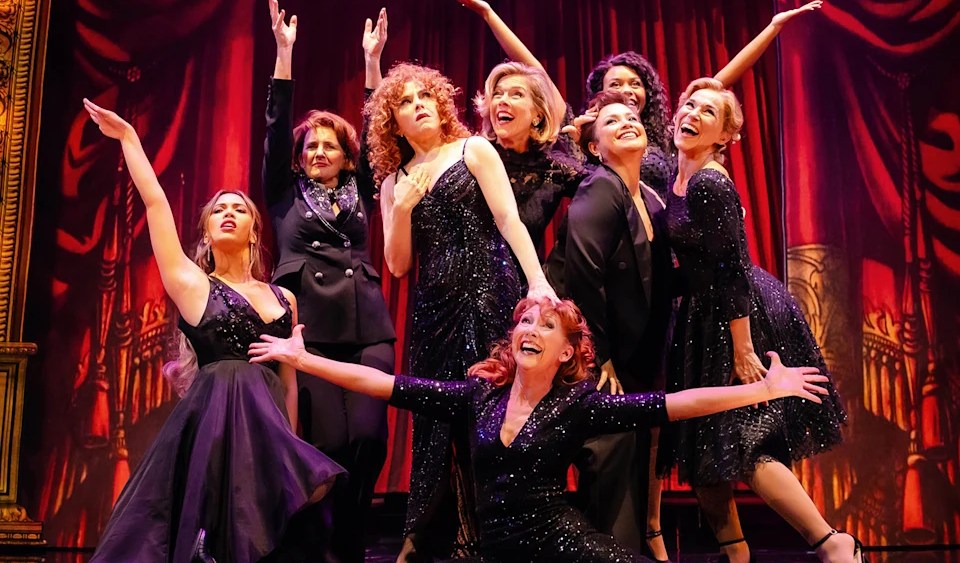‘Stephen Sondheim’s Old Friends’: Behind L.A.’s Broadway-Bound Revue
Everything’s coming up you-know-what if you’re a Sondheim fan on either coast this season. “Stephen Sondheim’s Old Friends,” the third revue to be built around the great composer’s songbook — and the first such newly conceived production in more than 30 years — is headed to Broadway in March, with an ensemble cast led by Bernadette Peters and Lea Salonga. But before it heads east, a four-week preview run in L.A. officially kicks off tonight at the Ahmanson, where director Matthew Bourne and producer Cameron Mackintosh are working on getting the large ensemble to really feel like the old pals of the title.
If the roses bloom, it should be a heaven of a sendoff for Sondheim, who died at age 91 in September 2021. He passed about a year after pitching the idea of a revue that would complete a trilogy started with “Side by Side by Sondheim” in the ‘70s and “Putting It Together” in the ‘90s, incorporating material from the entirety of what many consider modern musical theater’s most brilliant career.
L.A. is getting “Old Friends” before Broadway, but it’s not first. The show already recently completed an initial run on London’s West End with some, not all, of the same cast, and met with rave reviews. “I was so thrilled how much the audience loved it and by the end of the show were so moved,” says Peters, who has starred in six Sondheim productions prior to this. “You look out in the audience and it’s people from walks of life who all appreciate how Steve wrote about different aspects of the human condition — the passion of it, the yearning of it, the dramatic part of it, the funny part of it. … He wrote with such depth that each song is like a little story that holds up on its own” — outside of the numbers’ origins in musicals from “Gypsy,” “Company” and “Follies” to “Into the Woods,” “A Little Night Music” and even “Passion.”
Peters, Mackintosh and Bourne all spoke with Variety about the very short and seemingly charmed history of this particular compendium, starting with the spark of an idea from the master himself during the pandemic.
“It was Steve’s idea,” emphasizes Mackintosh, a legendary theater figure in his own right, who has produced Sondheim shows in the U.S. and on the West End going back to the mid-’70s. “The idea for ‘Old Friends’ came during COVID when Steve was stuck in Connecticut and I was stuck in my farm in Somerset, wondering when the theaters were ever gonna reopen. He said, ‘Look, what about doing a third revue? Because we might as well. We haven’t done one since ‘Putting It Together.’ Look, there’s all that material, and let’s do something that would end a trio.’ We worked on it and did our lists and things. And then the theater reopened and we both got busy.” (Sondheim, for his part, turned toward trying to finish one last original musical, “Here We Are.”) “And then, sadly, Steve left us, leaving me with all his notes. A few weeks after he died, I decided I’d sit down and complete the show. And luckily, from up above, he sent all the inspiration down, so all the songs fell rather miraculously onto the page, and hardly changed at all” in the interim iterations.
Doing an all-new revue appealed to Sondheim far more than expanding one of the previous two. “When we did ‘Side by Side,’ it was of course before he’d written ‘Sweeney Todd,’ and then I remember how people would say, ‘Oh, wouldn’t it be great to have some numbers from “Sweeney Todd”? Couldn’t we (add) “A Little Priest”? That would wonderful.’ But Steve said, ‘If the show works miraculously, don’t change it. We can always do another show.’ And, you know, ‘A Little Priest’ had to wait till ‘Old Friends,’ to make its spectacular appearance in this production. I think he’d be very pleased at how well it works here… watching Lea and Jeremy Secomb do it is absolutely fantastic.”
What separates “Old Friends” from the previous two authorized Sondheim revues, apart from just having additional subsequent material to work with?
“Well, there are two things (distinct) about this one,” Mackintosh says. “The original one, which was the first big hit show I ever had, was ‘Side by Side by Sondheim,’ which was written by three actors, really, and they’d done it as a love letter to Steve, because they loved performing it before he was well-known. That turned out to a huge hit both around the world and it came to America and was done all over the place, but it was basically the songs with a little narration. The second one, which I did it in New York with Julie Andrews and with Carol Burnett here in L.A. at the Mark Taper, was put together by Julie McKenzie Moore, and it had a little bit of a story which pulled it together. But it was also (representing) the post-early musicals, and therefore it was dealing with the more serious side of what Steve had written.
“This third one really has been drawn from all the shows that I’ve done with Steve, from the production of ‘Follies’ in London to the special material he did for my own show, ‘Hey, Mr. Producer.’ It’s mostly been drawn from about five shows, plus a few other songs which meant something especially to Steve. But by and large, my idea was to put together in this show all the greatest songs. Everyone says that Steve was the greatest lyricist, but he’s also written some of the greatest, catchiest songs that have ever been written for the musical theater. So, in fact, what’s driven this is his love of Broadway, and his love of having shows seen by as many people as possible. And so every single song is absolutely brilliant — and, mostly, joyful. Some of them are wonderfully poignant as well, but mostly what we’ve put on the stage, and what’s attracted so many brilliant performers, is to show how much fun you can have with Sondheim, as well as truth from the master of lyrical writing.”
Even before “Old Friends” premiered in London last year, there was one previous early incarnation of the show, presented as a one-off gala salute to Sondheim that very few people at the time realized was intended to be the basis of a full-on Broadway (and likely future touring) production. Among the people who had no clue about this when the gala was produced was the renowned director Mackintosh roped into helming that, and everything that has followed, Bourne.
“Having worked with Cameron for many years now, he often has a plan in his head that he doesn’t share with you at the beginning,” the director laughs. Only later did he learn that “it was, without me knowing, really intended to be a (long-running) stand-alone show rather than just a one-off gala.
“My journey with it is quite strange,” adds Bourne, legendary for ground-breaking, ballet-based shows like “Swan Lake” as well as working with Mackintosh on more traditional musicals like “My Fair Lady” and “Mary Poppins.” Although Bourne has his own long association with Mackintosh, “My initial reaction was, why me? I had no history with Stephen Sondheim at all. I’d never met him. And I’ve come from dance theater shows.” The irony that some of the productions he’s most famous for are not so wordy is not lost on him — “fewer if any words,” he laughs. “So it’s a new thing for me, which I’ve really enjoyed.”
Bourne had some help in different areas of his duties, with veteran Sondheim director Julia McKenzie, who is retired, making herself available for consultation, while Stephen Mear handled the choreography. “I’ve been more involved in the staging where the numbers are staged rather than dance,” he says, counterintuitive as that might seem — “things like ‘Getting Married Today’ and ‘Weekend in the Country.’ It was a little bit different from what I normally do, and I really enjoyed working with words, because I’m a dance person. I really loved delving completely into the words. it was material I was very aware of, and that I grew up with — a lot of it, not all of it, but most of it — and I knew some of the lyrics better than people who’d actually been in the shows.”
Mackintosh recently hired Bourne to direct a new version of “Oliver” on the West End, so it’s not like he didn’t already have him on speed-dial. The producer recalls their early work together: “Matthew is definitely an old friend, and we’ve been working together since he was a baby, really. I mean, he was in his late twenties when I first met him, and I did the first version of ‘Oliver,’ which is completely different from the one I’ve just opened in London with him, at the Palladium; that one was really a big stage version of the movie. And I had two young people I decided (should collaborate on it): a young Matthew Bourne, and a young Sam Mendes, who directed. And we’ve been friends ever since,. He did the brilliant ‘Swan Lake’ shortly after that, and I took his production to Broadway; I think it’s the longest-running ballet in the history of Broadway. He’s done ‘Mary Poppins,’ which is still going on all over the world; I’ve just done a fantastic new production in England, which is the best one yet, which I’m hopefully bringing to America in about 18 months’ time. … So we’ve had such a long friendship that this to me was just the perfect show for him.”
Why give L.A. audience a head start on New York ones? “I have an enormous history with, with the Center Theatre Group and I’ve been coming for nearly 30 years with my own shows,” Bourne says. Mackintosh also fondly recalls putting together “Putting It Together” at the Mark Taper in the ‘90s before taking it to Broadway. Says Bourne, “We’ve got this interesting mixture of some of the original British cast who have come over to do it and a whole new bunch of really great Broadway performers, so we need a bit of time to create that group of friends — the people who are happy to work on stage supporting each other, literally, as ensemble members.” In this show, even the marquee performers, Peters and Salonga, stick around a lot of the time for numbers where less legendary cast members are taking the lead.
Mackintosh is happy to be reunited with Peters as she reunites with Sondheim. “Talking about ‘I Know Things Now,’ she said, ‘I’ve got an idea of how to do it as an older person now,’ from someone who genuinely was there and involved with Steve… There’s that moment in the show where suddenly she’s playing Dot again [her character from her first Sondheim show, 1984’s “Sunday in the Park With George”]. It doesn’t matter how often you see it, it just takes your breath away.”
There wasn’t a lot to re-learn for Peters; when she headlined Carnegie Hall last fall, 13 of her 19 song choices were Sondheim tunes… although there’s actually not that significant an overlap between what she does in her own shows and what she’s singing completely afresh in “Old Friends.”
Mackintosh says that Peters has not just the right chops “but the right heart for this… It’s an ensemble piece, and it’s rare to have artists of this caliber all being with each other, all supporting each other” even in scenes in which they are not individually featured. “And it all flows from the center, with Bernadette. And Lea’s exactly the same; since I first discovered her for ‘Miss Saigon’ all those years ago, back in the late ‘80s, she’s always been like that too. I remember when I first explained this to her and I said, ‘You’d be singing (lead on) this, you’d be singing that, but you’re also (in the background) in the ensemble numbers.’ And she said, ‘Well, of course I would be. You need actors in there. Why wouldn’t I be in it?’ That’s what you want.”
Says Bourne, “We’ve got great people in the show and they all do have their show-stopping moments, but Bernadette brings this real connection with Steve that’s sort of unparalleled, really. And there are magical moments in the show where we know that she was in this show. She’s not necessarily singing the same material she did in the show, which she likes to do; she’s sort of chosen some songs that she’s not known for. But I feel we’re really connected with Steve when she’s on stage. And I think without her name attached to it, it would still be a great show, but she’s the magic that makes it really, really special. I said to her the other night, at a drinks thing we were having, I said, ‘You’re gonna have to do this forever. I’m not sure we can do this (otherwise).” She was like [taken aback], ‘Oh, OK, well… maybe. Maybe.’
“But you’ll see. At the end of the show, when it becomes more about Steve and she sings things like ‘Not a Day Goes By,’ where there is a montage of pictures of him, and some of them are with her and it’s very personal. It’s a personal thing, and I think that’s what touches people enormously.
Mackintosh’s favorite song in “Old Friends” happens to be “Not a Day Goes By,” “one of his most extraordinary poignant songs, which encapsulates our love for Steve and what it means to have lived with a genius like him.” But, the producer adds, he is also highly inclined toward the zippier numbers in the show that bring on the aforementioned joy. “I’m a Broadway baby at heart, so I absolutely adore that stuff as well. There isn’t a song in the show that I don’t go, ‘You know, I could die tomorrow, just hearing that one again.’”
Peters didn’t have a chance to discuss “Old Friends” with Sondheim like Mackintosh did. “I never discussed this with Steve because Steve was really writing that last show, and in fact, I did a reading of the last reading of it (“Here We Are”), and then he went into production, so he was focused on that.” But she has a near-lifetime of doing Sondheim on stage that gives her all the background she needs. “I don’t particularly have any tongue twisters or anything like that in the show,” she says, “and basically there’s no secret except to follow the map of what he wrote, in both the music and the lyrics.
“His intention is just right there on the page, and that’s all you really have to really have to follow. The thing about it is, the longer you live, the more information about life you have to bring into the music. That’s what I’ve learned.”
How many Sondheim shows has she done? “I think Stephen told me I did six,” Peters says. Apparently she’d been thinking five, “and he goes, ‘No, “Gypsy,” too,’ because he wrote the lyrics for ‘Gypsy.’ But now I have to add this — this makes seven. I think Cameron put all the songs in all the right places, and it’s quite beautiful — the arc of it flows in a really lovely way. Even though it’s intellectual, it’s entertaining and it’s emotional. And uplifting — a show like that right now is perhaps what is good for the public.”
Is there a favorite number in the show for Peters, like one of the major ballads? “Not really, although I do play the trumpet as Mazeppa” — the horn-blowing stripper from “Gypsy,” who comes back to life in “Old Friends” via a rousing revival of “You Gotta Get a Gimmick.” Peters has been known for her trumpeting skills before (she convincingly trumpet-synched in the film “The Jerk”), but she’s made some strides lately to do Sondheim justice in this new show. “That’s always fun, but then my trumpet playing got better, and I’m like, ‘Hey, there’s a melody coming out of this thing all of a sudden!’ So that’s exciting.”


